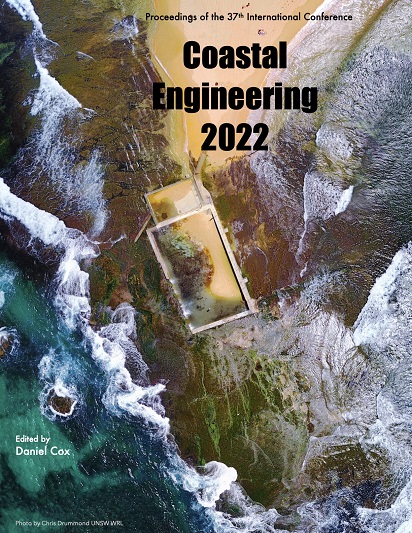Abstract
Nature-based solutions (NBS) represent a new field of research and engineering applications, becoming increasingly popular in the coastal engineering field. Salt marsh restoration, an example of NBS, is particularly appealing due to the variety of benefits they can provide, especially their capacity to induce sediment accretion, potentially keeping pace with sea-level rise. This study investigates the applicability of the flexible fluid-structure (FSI) interaction module being developed for open-source software REEF3D to the motion of marsh plants under wave action using data from a physical model study performed by Paul et al. (2016). The model consistently overestimates the drag force response of a flexible plastic plant surrogate under wave action. This suggests that this new tool may not be suited for this case. However, further investigation must be performed to test the limits of the model’s application.References
Arunakumar, H. S., Suvarna, P., Abhijith, P. A., Prabhu, A. S., Pruthviraj, U., & Kamath, A. (2019). Effect of Emerged Coastal Vegetation on Wave Attenuation Using Open Source CFD Tool: REEF3D. Proceedings of the Fourth International Conference in Ocean Engineering, 591–603.
Bihs, H., Kamath, A., Chella, Mayilvahanan Alagan Ahmad, N., Aggarwal, A., Wang, W., Martin, T., & Fornes, P. (2018). REEF3D :: User Guide 18.01. NTNU: Norwegian University of Science and Technology.
Bihs, H., Kamath, A., Pakozdi, C., Martin, T., & Wang, W. (2021). REEF3D (21.11) [Computer software]. NTNU Trondheim. https://reef3d.wordpress.com/
Chakrabarti, A., Brandt, S. R., Chen, Q., & Shi, F. (2017). Boussinesq modeling of wave-induced hydrodynamics in coastal wetlands. Journal of Geophysical Research: Oceans, 122, 3861–3883. https://doi.org/10.1002/2016JC012264
Garzon, J. L., Maza, M., Ferreira, C. M., Lara, J. L., & Losada, I. J. (2019). Wave Attenuation by Spartina Saltmarshes in the Chesapeake Bay Under Storm Surge Conditions. Journal of Geophysical Research: Oceans, 124(7), 5220–5243. https://doi.org/10.1029/2018JC014865
Garzon, J. L., Miesse, T., & Ferreira, C. M. (2019). Field-based numerical model investigation of wave propagation across marshes in the Chesapeake Bay under storm conditions. Coastal Engineering, 146(November 2018), 32–46. https://doi.org/10.1016/j.coastaleng.2018.11.001
Ghisalberti, M., & Nepf, H. M. (2002). Mixing layers and coherent structures in vegetated aquatic flows. Journal of Geophysical Research, 107(C2). https://doi.org/10.1029/2001jc000871
He, F., Chen, J., & Jiang, C. (2019). Surface wave attenuation by vegetation with the stem, root and canopy. Coastal Engineering, 152(December 2017), 103509. https://doi.org/10.1016/j.coastaleng.2019.103509
Lei, J., & Nepf, H. (2019). Wave damping by flexible vegetation: Connecting individual blade dynamics to the meadow scale. Coastal Engineering, 147(October 2018), 138–148. https://doi.org/10.1016/j.coastaleng.2019.01.008
Martin, T., & Bihs, H. (2021). A non-linear implicit approach for modelling the dynamics of porous tensile structures interacting with fluids. Journal of Fluids and Structures, 100, 103168. https://doi.org/10.1016/j.jfluidstructs.2020.103168
Martin, T., & Bihs, H. (2021). A numerical solution for modelling mooring dynamics, including bending and shearing effects, using a geometrically exact beam model. Journal of Marine Science and Engineering, 9(5), 1–27. https://doi.org/10.3390/jmse9050486
Martin, T., Tsarau, A., & Bihs, H. (2020). A numerical framework for modelling the dynamics of open ocean aquaculture structures in viscous fluids. Applied Ocean Research, 1. https://doi.org/10.1016/j.apor.2020.102410
Miquel, A. M., Kamath, A., Chella, M. A., Archetti, R., & Bihs, H. (2018). Analysis of different methods for wave generation and absorption in a CFD-based numerical wave tank. Journal of Marine Science and Engineering, 6(2), 1–21. https://doi.org/10.3390/jmse6020073
Paul, M., Rupprecht, F., Möller, I., Bouma, T. J., Spencer, T., Kudella, M., Wolters, G., van Wesenbeeck, B. K., Jensen, K., Miranda-Lange, M., & Schimmels, S. (2016). Plant stiffness and biomass as drivers for drag forces under extreme wave loading: A flume study on mimics. Coastal Engineering, 117, 70–78. https://doi.org/10.1016/j.coastaleng.2016.07.004
Short, F. T., Kosten, S., Morgan, P. A., Malone, S., & Moore, G. E. (2016). Impacts of climate change on submerged and emergent wetland plants. Aquatic Botany, 135, 3–17. https://doi.org/10.1016/j.aquabot.2016.06.006
Tschisgale, S., & Fröhlich, J. (2020). An immersed boundary method for the fluid-structure interaction of slender flexible structures in viscous fluid. Journal of Computational Physics, 423, 109801. https://doi.org/10.1016/j.jcp.2020.109801
Vuik, V., van Vuren, S., Borsje, B. W., van Wesenbeeck, B. K., & Jonkman, S. N. (2018). Assessing safety of nature-based flood defenses: Dealing with extremes and uncertainties. Coastal Engineering, 139(April), 47–64. https://doi.org/10.1016/j.coastaleng.2018.05.002
Zhang, X., & Nepf, H. (2021). Wave-induced reconfiguration of and drag on marsh plants. Journal of Fluids and Structures, 100, 103192. https://doi.org/10.1016/j.jfluidstructs.2020.103192

This work is licensed under a Creative Commons Attribution 4.0 International License.
Copyright (c) 2023 Ross Henteleff, Acacia Markov, Jacob Stolle, Ioan Nistor, V Sriram

